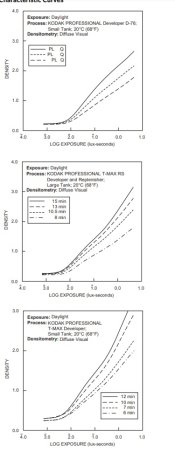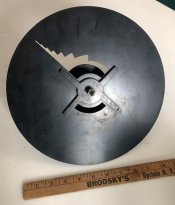138S,
Now we're getting somewhere!
Doremus, the ISO speed provided (by principal manufacturers) do apply perfectly, Kodak graphs in the datasheets have absolute Lux.Second units, so it's totally precise information.
Of course it's totally precise information. The thing is, it
doesn't necessarily apply to a particular practical application. I don't have Kodak's meters. I meter real-life things in lots of different lighting; my readings aren't going to be anywhere close to as precise as Kodak's when it comes to getting the same amount of photons onto the film. I'm aware of that. I certainly believe Kodak gets the results they get. I simply cannot duplicate that. Nor can you.
Of course your particular processing may vary the Speed Point (exposure for 0.1D+FB) by some 1/3 stop exposure, but not by 1 stop or the like, what probably you adjust.
Just one of many variables that can influence the total outcome and just another reason to do one's own testing and arrive at a personal E.I. FWIW, some contractions require even more than a stop of compensation. But even if we're talking "Normal" development, developer choice and agitation method can deviate from the ISO standard development by a significant amount.
Kodak tells you that (developed with D-76) gray spots at 3.33 underexposure will deliver around that 0.1D+FB, and believe me, they are not wrong. If you use HC-110 then it would be 3 stops, and if you use Xtol it would be around 3.5.
Yes, I believe Kodak can do that. And, with my much-less-precise metering, etc. I can easily get within a stop or so of that. I'd just like to refine that a bit. You seem to think that we photographers have equipment and conditions that can duplicate Kodak's laboratory results. That's simply not true. We're lucky if we come close.
Of course one may test all what he wants to correct his own repetitive errors...
Well, I don't know if I'd call deviations from Kodak's lab results "errors." I do as well as I can with what I have. My Pentax spotmeter has flare that influences the shadow readings. I'll bet Kodak didn't have that problem. I've also got flare from other sources (camera bellows, enlarger, etc.) that needs to be compensated for; Kodak didn't have to do that either. Etc., etc... The point is, I'm not "correcting" anything, but compensating for the real-life situation that I find myself in. If I have to rate my film a couple thirds of a stop differently than ISO standard to get consistently better results, I'm going to do it.
What you don't understand in these graphs ?
I understand the graphs. They're great for comparing films and learning about a specific film's characteristics. Still, they don't help me with a choice for rating my film speed in my particular situation.
They tell you exactly at what exposure you'll get the Z-I in lux.second, so what your meter has to aim. It's about knowing how to read datasheet, and predicting the (max) 0.3 stop shift from the developer kind, at that point we all know if a particular developer will gain or loss a (mostly irrelevant) 1/4 of stop. We may have some variability for the contrast index (agitation, temperature, etc)... but Z-I exposure is precisely known from datasheet !!!
I really do believe that x-amount of lux-seconds will get my x density on x film with x developer for x time with x agitation. Really, I do. I'm just not able to measure light and expose that precisely in the real world. My meter isn't Kodak's, and it doesn't read the same nor is it as precise. (If you've got a light meter that works that accurately in practice, I'd love to get my hands on one!)
So, how do I get my meter to match Kodak's? Well, I can never be that precise, but I can come up with an average value based on lots of metered shadows that allows me to find a factor to change my meter settings so that, in general, I get similar results. It's called a personal E.I. It is not based on sensitometry, but from my personal negatives and my particular meter.
But, you're still overlooking some things: what if I want my Zone I to be higher than 0.1 above fb-fog? Or what if I want to base my effective film speed on Zone III? Well, my E.I. is likely going to be a bit different than the ISO, but I digress...
Really, finding what gives you the shadow detail and separation you want is what finding a personal E.I. is all about. It is not sensitometry! You seem to be confusing the two.
Look, Kodak was the first to recognize that their lab results don't always apply exactly to real-life scenarios. Their advice shows this. I'm paraphrasing here, but it goes something like this:
If your negatives are consistently to thin, give more exposure (by rating your film differently from the ISO rating!) and vice versa. Kodak is, in essence, suggesting you find your own personal E.I. if your results are not acceptable at the ISO rating.
I think that's good advice. The Zone System simply takes that a bit further and helps quantify things more by testing a bit. Still, one can just follow Kodak's advice and arrive at the same point; a personal working E.I. that takes one's particular situation into account.
And, don't get me wrong. If my personal E.I. were way different than the ISO, I'd be looking for errors in my processing or faulty equipment. I've never had an E.I. for "Normal" that was more than a stop different from the ISO. So, one could likely do just fine using box speed most of the time, especially with negative film. But that's not the issue here. What I'm trying to convince you is that all the science you present, while perfectly good, is not what finding a personal E.I. is about. Finding your own E.I. is simply about finding a setting on your meter that, although it might be different from ISO speed for whatever reason, gives you better exposures. That's all.
Best,
Doremus








